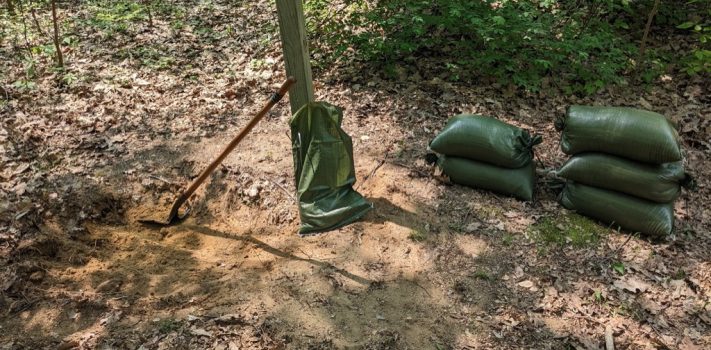I have a makeshift shooting range behind my pole barn. In the backstop behind the target stand, I had used a sloping wall of sand to absorb the energy of the bullets entering the backstop.
The major problem with a sloping wall of sand is that it is thinner at the top than it is at the bottom. This leaves the top of the wall of sand weaker than the bottom. With that in mind, I usually only used the targets near the bottom of the target stand when I was shooting a more powerful firearm, like a centerfire rifle.
During a recent range session, I was shooting a rifle chambered in 6.5x55mm Swedish. I forgot my own guideline about only shooting at targets near the bottom of the target stand, and used the top row of targets. As a result, several bullets scattered the top of the sloping wall of sand and penetrated beyond the rear wall of the backstop. Fortunately, I have a sand hill behind the backstop. That hill stopped the errant bullets.
Having a backstop that does not stop bullets is not particularly helpful. I decided that I needed some sandbags to hold a thicker layer of sand in place near the top of the backstop.
An online search revealed that a company called Tapix sells sandbags in bundles of 100. At the time of this writing (June, 2023), a bundle of 100 sandbags cost $35.99 at Tapix.net.
I contacted Tapix and asked if they could provide me with a bundle of 100 of their military green empty sandbags for review. They were kind enough to agree. Three days later, UPS dropped a box off at my house.
First Impressions
The shipping box measured approximately 14.75 x 14.25 x 13.75 inches, and weighed about 9 pounds according to the UPS shipping label.
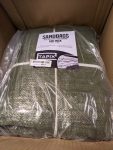 The bags each measure 14 x 26 inches and are made of woven polypropylene. They are supposed to be UV resistant. That should not be a significant consideration, since the bags should have minimal UV exposure inside the backstop. Each bag is supposed to weigh approximately 50 pounds when filled 80% full with sand. The ties are attached.
The bags each measure 14 x 26 inches and are made of woven polypropylene. They are supposed to be UV resistant. That should not be a significant consideration, since the bags should have minimal UV exposure inside the backstop. Each bag is supposed to weigh approximately 50 pounds when filled 80% full with sand. The ties are attached.
Tapix noted that the bags are designed primarily for flood protection, and requested that I share my findings with them about their appropriateness for shooting range use.
As I opened the package, I was embarrassed to note that the bags are made in mainland China. I was unaware of this when I requested the bags. I should have done better preliminary research, since I try to avoid reviewing products that are made in mainland China. Several American companies also make sandbags, and I could have contacted any of them if I had done my homework more carefully. However, since Tapix provided the sandbags in good faith, I felt responsible for giving them an honest review.
Preparing the Sandbags
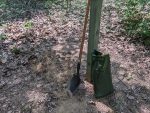 I mined the sand to fill the bags from the area next to the 25-yard marker on the range. There is a slope in that area, and I sought to level it out somewhat. The woods around my home contain many marshy areas. Those marshy areas breed mosquitoes. Those mosquitoes were out in force on that late spring/early summer evening. I put on a broad-brimmed hat and a bug jacket, and was able to work in the cloud of mosquitoes in relative comfort without being drained of my lifeblood, or even worse, slapping myself to death.
I mined the sand to fill the bags from the area next to the 25-yard marker on the range. There is a slope in that area, and I sought to level it out somewhat. The woods around my home contain many marshy areas. Those marshy areas breed mosquitoes. Those mosquitoes were out in force on that late spring/early summer evening. I put on a broad-brimmed hat and a bug jacket, and was able to work in the cloud of mosquitoes in relative comfort without being drained of my lifeblood, or even worse, slapping myself to death.
I quickly noticed that when the bags are 80% full, their footprint is reduced from 14 x 26 inches to approximately 11 x 17 inches due to the curvature of the sides of the bags and the need to leave some material at the top of each bag to allow it to be tied off. For my first test, I prepared 9 sandbags.
Test #1
For the first test, I used 9 sandbags to prepare a safety revetment for use while test firing an antique Smith and Wesson .38 S&W double action top-break revolver from my collection.
Since the revolver was manufactured in 1882, I wanted a way to safely test fire it before using it just an arm’s length away from my face during regular shooting. I had carefully inspected the revolver and function tested it while unloaded, but the proof of the pudding is in the eating, and the proof of the revolver is in the shooting.
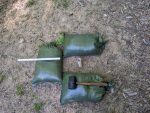 To safely test fire the revolver, I constructed a 3 sided sandbag revetment that was stacked 3 sandbags high around a 2-foot section of 1.5 inch PVC pipe that was driven into the ground. I had placed a short section of 0.5-inch diameter PVC to run from the inside to the outside of the revetment between the lowest and middle sandbags in the center stack. I placed the revolver handle in the end of the 1.5-inch PVC pipe. I had wrapped innertube rubber around the handle of the revolver to give it a snug fit and to protect the fragile gutta percha grip.
To safely test fire the revolver, I constructed a 3 sided sandbag revetment that was stacked 3 sandbags high around a 2-foot section of 1.5 inch PVC pipe that was driven into the ground. I had placed a short section of 0.5-inch diameter PVC to run from the inside to the outside of the revetment between the lowest and middle sandbags in the center stack. I placed the revolver handle in the end of the 1.5-inch PVC pipe. I had wrapped innertube rubber around the handle of the revolver to give it a snug fit and to protect the fragile gutta percha grip.
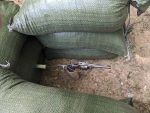 Next, I ran a thin steel cable through the 0.5 inch PVC pipe, and secured it to the trigger with a ranger band cut from a section of bicycle innertube. The cable ran to a point 15 yards behind the sandbag revetment. I tested the arrangement with the revolver unloaded. After suitable adjustments, this testing confirmed that the trigger could be pulled and the revolver dry-fired with the larger piece of PVC pipe holding the revolver securely pointed toward the lower portion of the backstop.
Next, I ran a thin steel cable through the 0.5 inch PVC pipe, and secured it to the trigger with a ranger band cut from a section of bicycle innertube. The cable ran to a point 15 yards behind the sandbag revetment. I tested the arrangement with the revolver unloaded. After suitable adjustments, this testing confirmed that the trigger could be pulled and the revolver dry-fired with the larger piece of PVC pipe holding the revolver securely pointed toward the lower portion of the backstop.
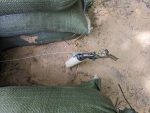 I then loaded the revolver, and fired all 5 chambers, one by one. I stopped between each shot to verify that the revolver was still pointing in the desired direction. The revolver passed this particular safety test. And I felt great running the safety test with a sandbag revetment and 15 yards of space between me and the revolver.
I then loaded the revolver, and fired all 5 chambers, one by one. I stopped between each shot to verify that the revolver was still pointing in the desired direction. The revolver passed this particular safety test. And I felt great running the safety test with a sandbag revetment and 15 yards of space between me and the revolver.
Further Preparation
The second test involved installing the bags in the backstop to serve their intended purpose.
I desired to install two rows of bags, so that whenever the first row of bags was no longer capable of holding sand, they could be replaced before the second row of bags was damaged by flying lead.
Since the bags averaged approximately 11 inches wide, I needed a level shelf at the top of the sand slope at least 22 inches wide to accommodate the 2 rows of bags. Preparing this shelf allowed enough room to stack the bags 2 high. Since the backstop is 65 inches wide on the inside, I could just barely squeeze 4 bags in each row. This meant that I would need a total of 16 bags: 2 rows that are each 4 bags long and 2 bags high.
With this in mind, I reused the 9 sandbags from the revolver testing, and filled an additional 7 bags to provide the necessary total of 16 bags.
Test #2
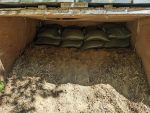 After the 2 rows were arranged inside the backstop, I did some test firing of a couple of different handguns: the above-mentioned Smith and Wesson, and a Trailblazer Firearms LifeCard in .22LR. This testing included the top row of targets, which exposed the sandbags in the backstop to pistol fire. When the testing was completed, I inspected the sandbags for damage. The polypropylene fibers closed around the bullet holes in the sandbags so well that not only did no sand leak out, but I was hard-pressed to find the places where the bullets had penetrated the bags.
After the 2 rows were arranged inside the backstop, I did some test firing of a couple of different handguns: the above-mentioned Smith and Wesson, and a Trailblazer Firearms LifeCard in .22LR. This testing included the top row of targets, which exposed the sandbags in the backstop to pistol fire. When the testing was completed, I inspected the sandbags for damage. The polypropylene fibers closed around the bullet holes in the sandbags so well that not only did no sand leak out, but I was hard-pressed to find the places where the bullets had penetrated the bags.
I was relieved, because I remembered certain scenes from the television series McHale’s Navy that I watched when I was a boy. In those scenes, a Japanese Zero would strafe American structures, such as air raid shelters or antiaircraft positions, that were protected by sandbags. The bullets would pierce the sandbags, and sand would run out of the bullet holes like it was running through an hourglass. Often this sand would fall into the face of Lieutenant Commander McHale’s nemesis, Captain Binghamton, who would be prone at the base of the structure in defeat after failing in another effort to get Lieutenant Commander McHale and his crew arrested or transferred.
I know that a sufficient number of bullets will eventually sever enough polypropylene fibers to allow the bags to leak. But it is good to know that this process may take longer than was suggested by television comedy back in the days of my youth.
Conclusions
Tapix sandbags seem to be an effective, reasonably priced solution for reinforcing the backstop of my improvised shooting range. I am glad to have them.
Disclaimer
Tapix was kind enough to provide me with a bundle of 100 of their military green sandbags for testing and evaluation. TrailBlazer Firearms was kind enough to provide me with a sample of their LifeCard folding derringer chambered in .22LR for testing and evaluation. I tried not to let the kindness of Tapix or TrailBlazer Firearms interfere with my objectivity in this review, and believe that I have succeeded. I did not receive any other financial or other inducement to mention any vendor, product, or service in this article.

